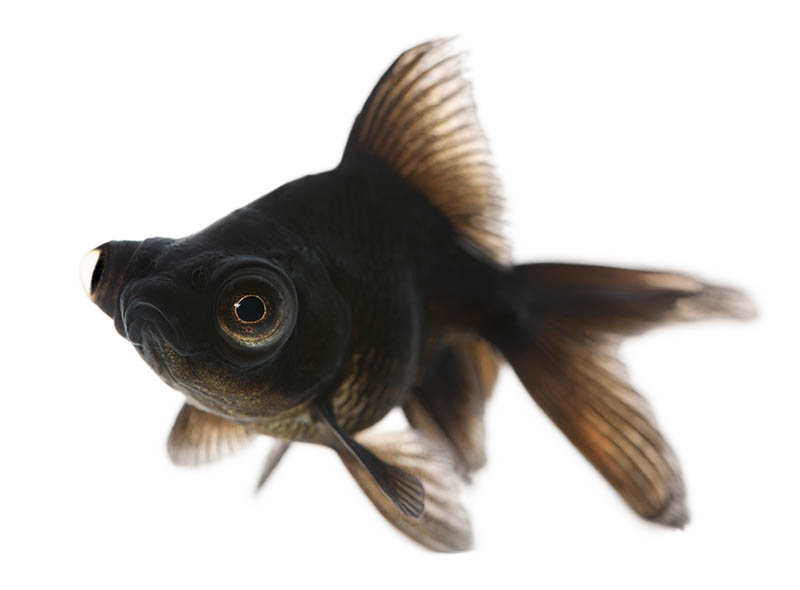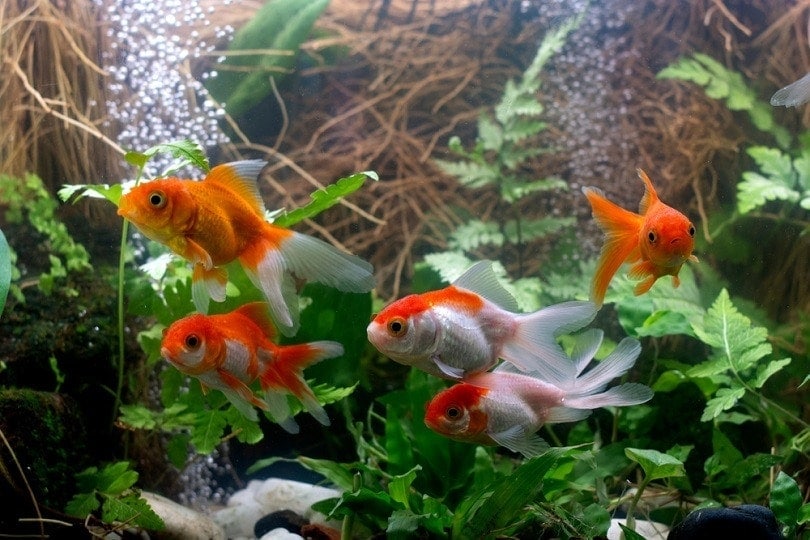Can Goldfish Live in a Bowl? Our Vet Answers!
By Dr. Luqman Javed, DVM (Vet)
Updated on

Goldfish are one of the most popular aquarium fish available today. They come in a striking array of colors, sizes, shapes, and fin configurations. In popular culture, the image of a goldfish in a fishbowl is extremely common. Consequently, many people often assume that housing goldfish in bowls is fine. However, goldfish should not be kept in fish bowls as it is detrimental for their health.
In this article, we will look at the origin of this concept, why it shouldn’t be used, and tips on selecting a tank for your goldfish.
The Origin of Goldfish in Bowls
Tracing the concept of goldfish being kept in bowls requires a look into their compelling history. Goldfish originate from China and were originally only kept by royalty. The royal dynasty back then viewed goldfish as a symbol of luck and fortune and housed them in ponds. On occasion, the goldfish would be temporarily displayed in relatively small containers for guests to admire them. However, these “relatively small” containers were still very large and were filled with fresh water by servants of royalty to ensure welfare for the prized goldfish. More importantly, they were just temporary holding containers for the fish, not a permanent home.
In the earlier years of fish keeping, bowls surged in popularity again, because of their shape. A wide belly and narrow neck, coupled with their narrow necks made them ideal for stacking, transporting, and temporarily displaying fish. Again, the intention was to use them just on a temporary basis. Unfortunately, despite advancements in fish transport methods, bowls have stuck around.
In many parts of the world, the lack of legislation allows goldfish to be handed out as gifts at carnival fairs and festivals. Bowls are often incorrectly given along with the fish. However, as we’ve learned from history, they aren’t intended or suitable as a long-term housing option for your fish.

The Problems with Fishbowls
When used for long-term housing of goldfish, fishbowls come with a plethora of problems. In fact, their incompatibility as a permanent tank for fish has led to some countries introducing legislature and law that have now banned them. Here are just some of the reasons why you shouldn’t house your goldfish in fish bowls.
1. Fishbowls are Small
The biggest issue with fishbowls is their small size, which isn’t enough space for a goldfish. Not only that, but goldfish are also social and prefer to live in groups. Studies have shown that goldfish benefit from living in groups. Not only is a fishbowl too small for a single goldfish, but a single goldfish placed in a bowl would also suffer from the lack of companionship offered by other goldfish.

2. Goldfish are Large
Even the smallest variety of goldfish can reach a body length size of at least 5 inches, with some goldfish varieties easily exceeding a foot (12 inches) in length. They would just be too stunted in a small bowl.

3. Bowls Have Lower Oxygen
Oxygen is vital for all life, and goldfish are no exception to this rule. In aquariums, oxygen exchange occurs at the water’s surface. However, the narrow neck of a fishbowl means that the oxygen level of the water in the bowl will be low, which isn’t ideal for goldfish.
4. Goldfish are Exceptionally Messy
Goldfish are high-waste producers. They produce high amounts of ammonia and feces. The small size of a bowl coupled with a messy fish is a recipe for disaster, and water quality can quickly take a turn for the worse when goldfish are housed in bowls.

5. Fishbowls are Difficult to Filter, Clean, and Maintain
The shape of a fishbowl makes them very incompatible with many different types of filters. Hang-on-back filters or canister filters often can’t be installed on a fish bowl, which severely limits the options of good filters available to use with bowls. Their shape also makes them more difficult to clean, as there is no easy way to clean the round walls of a bowl reliably. Large volumes of water changes can easily stress fish and can even result in losses, and the requirements of goldfish mean that maintaining good quality water in a fish bowl is extremely difficult.

Selecting a Tank For Your Goldfish
When keeping fish as a new hobby, the best option is to pick a rectangular or square-shaped fish aquarium that can hold at least 20–30 gallons of water. A tank bigger than that would be even better. Often, beginner fish keepers believe that they should start small, however, the truth is that smaller tanks are much more difficult to safely maintain and are best left to experts.
The reason why “bigger is safer” applies to fish tanks is because in many ways, keeping fish is akin to a science experiment with water. As a fish keeper, you would be taking care of the water and making sure the water parameters meet the requirements of your fish. In turn, your fish will be thankful for the well-maintained water quality and thrive.
The more volume of water your tank has, the greater your safety margin will be. For example, because a 10-gallon tank has 10 times the volume of water than a 1-gallon tank, it allows for higher safety margins for errors than its smaller counterpart. As you learn the ropes of fishkeeping as a beginner, the extra volume of water will be better for your fish. As a bonus, the extra space lets you keep more fish as well.
Furthermore, water parameters are much steadier in larger volumes than in smaller volumes, especially when you perform tasks such as adding food to your tank, doing water changes, and adding in more fish. Larger tanks also have more options for filters, ornaments, plants, substrate, and lighting fixtures.
For keeping long-bodied goldfish, such as the Common Goldfish and Comets, a tank of at least 55–75 gallons is recommended for two or three full-grown individuals. Fancy variants of goldfish are typically smaller but still need ample space—a tank that’s about 35–40 gallons in size could comfortably house two or three fancy goldfish. All goldfish require a cycled tank with filtration, enrichment, and safe water parameters. Tanks should not be kept in areas where the temperature fluctuates quickly. Large carp, such as koi, require pond setups.
Because Common Goldfish and Comets are much faster and bigger than their fancy counterparts such as the Ranchu, Oranda, Fantail, and Telescope, they shouldn’t be housed together as they may easily outcompete their fancy counterparts for food. Different varieties of fancy goldfish can be housed together.

Conclusion
In summary, fish bowls aren’t recommended for goldfish because they are very difficult to properly maintain and can’t meet a goldfish’s long-term housing requirements. Goldfish require large aquariums, which are much more humane, easier to maintain, and allow for more options.
Featured Image Credit: pritsana, Shutterstock












